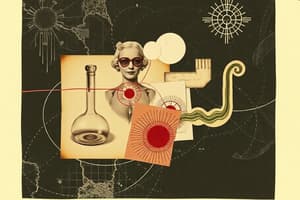Podcast
Questions and Answers
What is the primary characteristic of a lab-on-a-chip device?
What is the primary characteristic of a lab-on-a-chip device?
- It is a large-scale device that performs multiple laboratory functions
- It is a device that uses only microchannels for fluid flow
- It is a device that uses only micropumps for fluid manipulation
- It is a miniaturized device that performs various laboratory tasks on a small scale (correct)
What is the advantage of lab-on-a-chip devices in terms of sample consumption?
What is the advantage of lab-on-a-chip devices in terms of sample consumption?
- They require a large amount of sample
- They have no effect on sample consumption
- They minimize sample consumption and conserve valuable samples (correct)
- They increase sample consumption to achieve accurate results
What is the primary application of lab-on-a-chip devices in clinical diagnostics?
What is the primary application of lab-on-a-chip devices in clinical diagnostics?
- Disease treatment
- Disease detection, monitoring, and diagnosis (correct)
- Environmental monitoring
- Pharmaceutical research
What is the function of microchambers in lab-on-a-chip devices?
What is the function of microchambers in lab-on-a-chip devices?
What is the benefit of lab-on-a-chip devices in terms of speed?
What is the benefit of lab-on-a-chip devices in terms of speed?
What is the primary material used in soft lithography for fabricating lab-on-a-chip devices?
What is the primary material used in soft lithography for fabricating lab-on-a-chip devices?
What is the advantage of lab-on-a-chip devices in terms of accuracy?
What is the advantage of lab-on-a-chip devices in terms of accuracy?
What is the primary function of micropumps in lab-on-a-chip devices?
What is the primary function of micropumps in lab-on-a-chip devices?
What is the benefit of lab-on-a-chip devices in terms of portability?
What is the benefit of lab-on-a-chip devices in terms of portability?
What is the primary advantage of using photolithography in fabricating lab-on-a-chip devices?
What is the primary advantage of using photolithography in fabricating lab-on-a-chip devices?
Study Notes
Microfluidic Devices: Lab-on-a-Chip
Definition
- A lab-on-a-chip (LOC) is a type of microfluidic device that integrates multiple laboratory functions on a single chip.
- It is a miniaturized device that performs various laboratory tasks, such as chemical reactions, separations, and detections, on a small scale.
Key Features
- Small size: typically on the order of millimeters or centimeters
- Low sample volume: often in the range of microliters or nanoliters
- High surface-to-volume ratio: enables efficient heat transfer and chemical reactions
- Integration of multiple functions: allows for automation and miniaturization of laboratory processes
Advantages
- Reduced sample consumption: minimizes waste and conserves valuable samples
- Increased speed: enables faster analysis and detection
- Improved accuracy: reduces human error and increases precision
- Portability: enables point-of-care testing and field deployments
Applications
- Clinical diagnostics: disease detection, monitoring, and diagnosis
- Biotechnology: DNA analysis, protein analysis, and cell manipulation
- Pharmaceutical research: high-throughput screening, drug discovery, and development
- Environmental monitoring: water quality analysis, pollutant detection, and monitoring
Components
- Microchannels: narrow channels for fluid flow and mixing
- Microchambers: small compartments for chemical reactions and detections
- Micropumps: small pumps for fluid manipulation and control
- Sensors: integrated sensors for detecting physical, chemical, or biological parameters
Fabrication Techniques
- Photolithography: uses light to pattern materials on a surface
- Soft lithography: uses elastomeric materials to create microstructures
- 3D printing: uses layer-by-layer deposition to create complex structures
- Micro-molding: uses molds to create microstructures with high accuracy and precision
Microfluidic Devices: Lab-on-a-Chip
- A lab-on-a-chip (LOC) integrates multiple laboratory functions on a single chip, performing tasks like chemical reactions, separations, and detections on a small scale.
Key Features
- Small size: typically on the order of millimeters or centimeters
- Low sample volume: often in the range of microliters or nanoliters
- High surface-to-volume ratio: enables efficient heat transfer and chemical reactions
- Integration of multiple functions: allows for automation and miniaturization of laboratory processes
Advantages
- Reduced sample consumption: minimizes waste and conserves valuable samples
- Increased speed: enables faster analysis and detection
- Improved accuracy: reduces human error and increases precision
- Portability: enables point-of-care testing and field deployments
Applications
- Clinical diagnostics: disease detection, monitoring, and diagnosis
- Biotechnology: DNA analysis, protein analysis, and cell manipulation
- Pharmaceutical research: high-throughput screening, drug discovery, and development
- Environmental monitoring: water quality analysis, pollutant detection, and monitoring
Components
- Microchannels: narrow channels for fluid flow and mixing
- Microchambers: small compartments for chemical reactions and detections
- Micropumps: small pumps for fluid manipulation and control
- Sensors: integrated sensors for detecting physical, chemical, or biological parameters
Fabrication Techniques
- Photolithography: uses light to pattern materials on a surface
- Soft lithography: uses elastomeric materials to create microstructures
- 3D printing: uses layer-by-layer deposition to create complex structures
- Micro-molding: uses molds to create microstructures with high accuracy and precision
Studying That Suits You
Use AI to generate personalized quizzes and flashcards to suit your learning preferences.
Description
Learn about lab-on-a-chip devices, which integrate multiple laboratory functions on a single chip, performing tasks such as chemical reactions, separations, and detections on a small scale.




